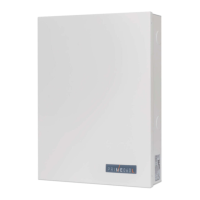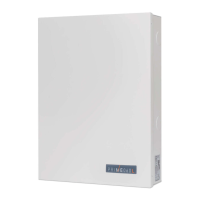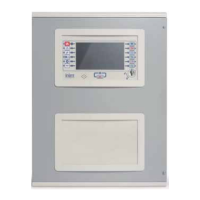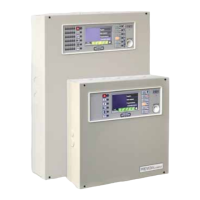Do you have a question about the INIM Electronics Prime and is the answer not in the manual?
Defines terms used in the Prime intrusion control system.
Explains symbols and notes used in the manual for clarity.
Provides contact information and details about the manufacturer, INIM Electronics s.r.l.
Details the procedure for programming the control panel using a keypad.
Explains how to program the system using the Prime/STUDIO software.
Covers setting up and programming keypads, including wireless types.
Details setting up and programming proximity readers, including wireless ones.
Explains setting up and programming expansion boards, including wireless ones.
Covers setting up and programming sounder/flashers, including wireless types.
Explains programming the Nexus module for GSM/GPRS functions.
Details programming parameters for wireless transceivers.
Explains how to set and use the installer code for system access and programming.
Details defining the control panel description and serial number.
Covers setting up network parameters for LAN connectivity.
Describes a preset configuration for connecting to the Inim Cloud service.
Outlines settings for compliance with EN50131 grade 3 regulations.
Describes how to select the system language for menus and descriptions.
Provides instructions for updating the firmware of the control panel.
Details parameters for configuring individual partitions, including timing and arming modes.
Explains how to configure terminals as inputs and program zone parameters.
Covers configuring terminals as outputs and setting output parameters.
Describes configuring a terminal to accept two different zones as a double zone input.
Explains configuring terminals as controlled outputs or for input/output operations.
Details enrolling and programming wireless terminals and their parameters.
Covers setting up arming scenarios, including icon assignment, output activation, and partition modes.
Details setting up timers for automatic arming, code/key authorization, and exceptions.
Explains how to change user PINs, including security compliance and default PINs.
Describes methods for accessing the user menu from keypads and software.
Covers setting parameters for user codes, including partitions, types, and enablements.
Details the procedure for enrolling digital and wireless keys for system access.
Covers setting parameters for individual keys, including partitions, timers, and shortcuts.
Explains programming telephone numbers, types, account codes, and SIA-IP settings.
Details telephone line parameters like channel, encryption, and dial-tone checks.
Covers programming actions for specific events, including notifications and shortcuts.
Details functions for managing and resetting event programming.
Explains associating output scenarios with event activation and restoral.
Describes programming periodic events with dates, times, and intervals.
Covers creating complex events using logical formulas, timers, and counters.
Details configuring e-mail settings for event notifications, including recipients and text.
Explains using graphic maps for installation monitoring via Alien keypads or web interface.
Covers configuring ONVIF cameras for remote video monitoring and event recording.
Details integrating the system with the KNX automation system via gateway parameters.
Provides instructions for updating the firmware of the PrimeLAN board.
Explains how to record, play, and manage individual voice messages.
Covers maintenance operations for the voice board, including reading and formatting.
Explains how to select and customize icons for keypad shortcuts.
Details associating specific icons with keypad shortcuts for user interaction.
Describes how to view and manage system events saved in the log, including filtering and export.
Explains how to reset the control panel to factory default parameters using various methods.
Lists functions available to installers via the keypad, including viewing status and activations.
Details guidelines and option enablement for EN50131 Grade 2 compliance.
Outlines additional requirements for EN50131 Grade 3 compliance, including anti-masking detectors.
Explains how to create and manage graphic maps for system visualization and interaction.
Describes how to monitor the status of remote keypads and use their buttons.
Explains how to monitor the arming status of partitions using color-coded icons.
Details monitoring terminal status using icons and managing zones/outputs.
Describes monitoring the status (enabled/operating) of timers in real-time.
Covers monitoring the status of peripherals like keypads, readers, and wireless devices.
Explains how to monitor the status, faults, and tamper conditions of sounder/flashers.
Describes how to perform a walk test to verify input detection and system coverage.
Details monitoring the status of power supplies, including primary and secondary sources.
Explains how to monitor the outputs and status of connected Flex5/DAC expansion boards.
Outlines the initial steps for starting the programming session for system installation.
Guides on renaming partitions for better identification within the system.
Details the process of programming zones and their associated terminals.
Describes adding a custom arming scenario for specific partition modes.
Explains associating partitions with readers and specific scenarios for access control.
Guides on linking keypads to specific partitions for system access.
Details programming devices connected to expansion board terminals.
Explains associating keys with partitions for access and control functions.
Details the procedure for enrolling keys using readers or keypads.
Guides on assigning shortcuts to keyfob buttons for arming and output control.
Details the process of enrolling wireless keyfobs using the transceiver.
Explains how to properly close the programming session and save changes.
Lists default programming settings for keypads.
Lists default programming settings for nBy readers.
Lists default programming settings for partitions.
Lists default programming settings for terminals.
Lists default programming settings for zones.
Lists default programming settings for outputs.
Lists default programming settings for scenarios.
Lists default programming settings for user codes.
Lists default programming settings for keys.
Lists default programming settings for telephone numbers and contacts.
Details default shortcuts and their functions across various interfaces.
Shows a table of default icons available for customization of keypad shortcuts.
Lists pre-recorded voice messages and their mapping to events, shortcuts, and partitions.
Provides a mapping of terminal numbers to devices and their CCC codes for CONTACT-ID reporting.
Details event types, triggers, restoration conditions, and pulse event status.
Explains how outputs and sounder/flasher behaviors combine based on event triggers.
Defines terms used in the Prime intrusion control system.
Explains symbols and notes used in the manual for clarity.
Provides contact information and details about the manufacturer, INIM Electronics s.r.l.
Details the procedure for programming the control panel using a keypad.
Explains how to program the system using the Prime/STUDIO software.
Covers setting up and programming keypads, including wireless types.
Details setting up and programming proximity readers, including wireless ones.
Explains setting up and programming expansion boards, including wireless ones.
Covers setting up and programming sounder/flashers, including wireless types.
Explains programming the Nexus module for GSM/GPRS functions.
Details programming parameters for wireless transceivers.
Explains how to set and use the installer code for system access and programming.
Details defining the control panel description and serial number.
Covers setting up network parameters for LAN connectivity.
Describes a preset configuration for connecting to the Inim Cloud service.
Outlines settings for compliance with EN50131 grade 3 regulations.
Describes how to select the system language for menus and descriptions.
Provides instructions for updating the firmware of the control panel.
Details parameters for configuring individual partitions, including timing and arming modes.
Explains how to configure terminals as inputs and program zone parameters.
Covers configuring terminals as outputs and setting output parameters.
Describes configuring a terminal to accept two different zones as a double zone input.
Explains configuring terminals as controlled outputs or for input/output operations.
Details enrolling and programming wireless terminals and their parameters.
Covers setting up arming scenarios, including icon assignment, output activation, and partition modes.
Details setting up timers for automatic arming, code/key authorization, and exceptions.
Explains how to change user PINs, including security compliance and default PINs.
Describes methods for accessing the user menu from keypads and software.
Covers setting parameters for user codes, including partitions, types, and enablements.
Details the procedure for enrolling digital and wireless keys for system access.
Covers setting parameters for individual keys, including partitions, timers, and shortcuts.
Explains programming telephone numbers, types, account codes, and SIA-IP settings.
Details telephone line parameters like channel, encryption, and dial-tone checks.
Covers programming actions for specific events, including notifications and shortcuts.
Details functions for managing and resetting event programming.
Explains associating output scenarios with event activation and restoral.
Describes programming periodic events with dates, times, and intervals.
Covers creating complex events using logical formulas, timers, and counters.
Details configuring e-mail settings for event notifications, including recipients and text.
Explains using graphic maps for installation monitoring via Alien keypads or web interface.
Covers configuring ONVIF cameras for remote video monitoring and event recording.
Details integrating the system with the KNX automation system via gateway parameters.
Provides instructions for updating the firmware of the PrimeLAN board.
Explains how to record, play, and manage individual voice messages.
Covers maintenance operations for the voice board, including reading and formatting.
Explains how to select and customize icons for keypad shortcuts.
Details associating specific icons with keypad shortcuts for user interaction.
Describes how to view and manage system events saved in the log, including filtering and export.
Explains how to reset the control panel to factory default parameters using various methods.
Lists functions available to installers via the keypad, including viewing status and activations.
Details guidelines and option enablement for EN50131 Grade 2 compliance.
Outlines additional requirements for EN50131 Grade 3 compliance, including anti-masking detectors.
Explains how to create and manage graphic maps for system visualization and interaction.
Describes how to monitor the status of remote keypads and use their buttons.
Explains how to monitor the arming status of partitions using color-coded icons.
Details monitoring terminal status using icons and managing zones/outputs.
Describes monitoring the status (enabled/operating) of timers in real-time.
Covers monitoring the status of peripherals like keypads, readers, and wireless devices.
Explains how to monitor the status, faults, and tamper conditions of sounder/flashers.
Describes how to perform a walk test to verify input detection and system coverage.
Details monitoring the status of power supplies, including primary and secondary sources.
Explains how to monitor the outputs and status of connected Flex5/DAC expansion boards.
Outlines the initial steps for starting the programming session for system installation.
Guides on renaming partitions for better identification within the system.
Details the process of programming zones and their associated terminals.
Describes adding a custom arming scenario for specific partition modes.
Explains associating partitions with readers and specific scenarios for access control.
Guides on linking keypads to specific partitions for system access.
Details programming devices connected to expansion board terminals.
Explains associating keys with partitions for access and control functions.
Details the procedure for enrolling keys using readers or keypads.
Guides on assigning shortcuts to keyfob buttons for arming and output control.
Details the process of enrolling wireless keyfobs using the transceiver.
Explains how to properly close the programming session and save changes.
Lists default programming settings for keypads.
Lists default programming settings for nBy readers.
Lists default programming settings for partitions.
Lists default programming settings for terminals.
Lists default programming settings for zones.
Lists default programming settings for outputs.
Lists default programming settings for scenarios.
Lists default programming settings for user codes.
Lists default programming settings for keys.
Lists default programming settings for telephone numbers and contacts.
Details default shortcuts and their functions across various interfaces.
Shows a table of default icons available for customization of keypad shortcuts.
Lists pre-recorded voice messages and their mapping to events, shortcuts, and partitions.
Provides a mapping of terminal numbers to devices and their CCC codes for CONTACT-ID reporting.
Details event types, triggers, restoration conditions, and pulse event status.
Explains how outputs and sounder/flasher behaviors combine based on event triggers.
| Partitions | 8 |
|---|---|
| Keypads | Up to 10 |
| IP Rating | IP30 |
| Communication | PSTN, GSM/GPRS, IP |
| Input Voltage | 230 V AC |








